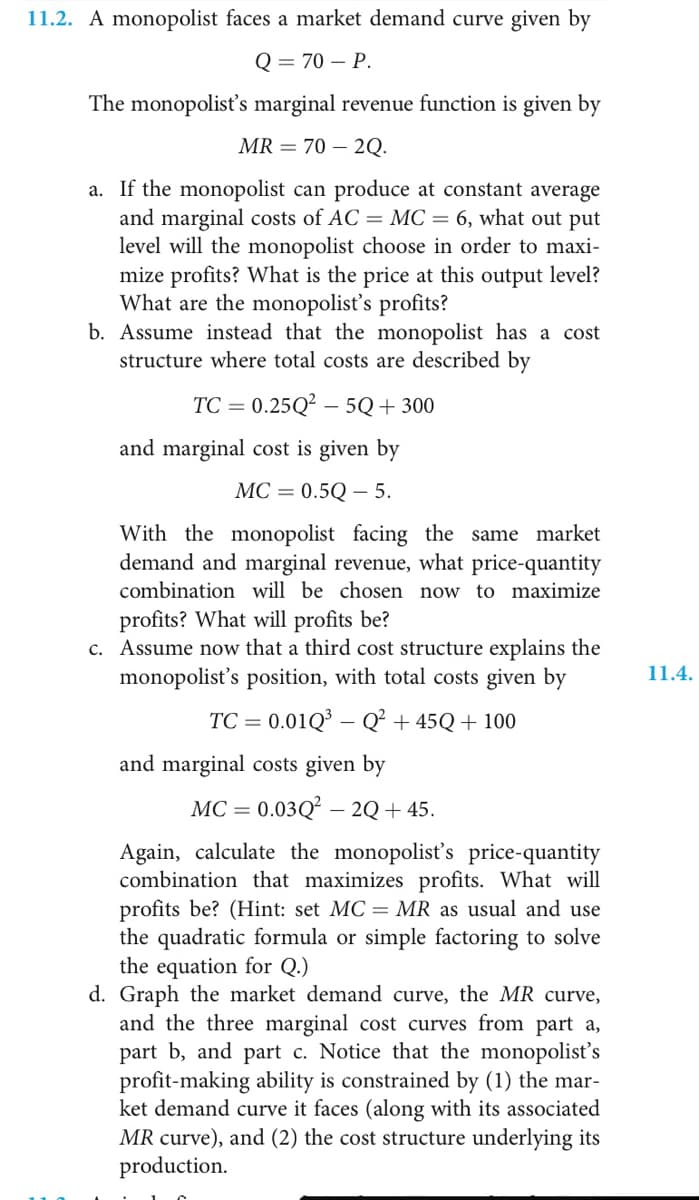11.2. A monopolist faces a market demand curve given by Q3D 70 — Р. The monopolisťs marginal revenue function is given by MR = 70 – 2Q. a. If the monopolist can produce at constant average and marginal costs of AC = MC = 6, what out put level will the monopolist choose in order to maxi- mize profits? What is the price at this output level? What are the monopolist's profits? b. Assume instead that the monopolist has a cost structure where total costs are described by TC = 0.25Q² – 5Q+300 and marginal cost is given by МС 3 0.5Q — 5. With the monopolist facing the same market demand and marginal revenue, what price-quantity combination will be chosen now to maximize profits? What will profits be? c. Assume now that a third cost structure explains the monopolist's position, with total costs given by 11 TC = 0.01Q³ – Q² + 45Q+ 100 and marginal costs given by MC = 0.03Q² – 2Q+45. Again, calculate the monopolisť's price-quantity combination that maximizes profits. What will profits be? (Hint: set MC = MR as usual and use the quadratic formula or simple factoring to solve the equation for Q.)
11.2. A monopolist faces a market demand curve given by Q3D 70 — Р. The monopolisťs marginal revenue function is given by MR = 70 – 2Q. a. If the monopolist can produce at constant average and marginal costs of AC = MC = 6, what out put level will the monopolist choose in order to maxi- mize profits? What is the price at this output level? What are the monopolist's profits? b. Assume instead that the monopolist has a cost structure where total costs are described by TC = 0.25Q² – 5Q+300 and marginal cost is given by МС 3 0.5Q — 5. With the monopolist facing the same market demand and marginal revenue, what price-quantity combination will be chosen now to maximize profits? What will profits be? c. Assume now that a third cost structure explains the monopolist's position, with total costs given by 11 TC = 0.01Q³ – Q² + 45Q+ 100 and marginal costs given by MC = 0.03Q² – 2Q+45. Again, calculate the monopolisť's price-quantity combination that maximizes profits. What will profits be? (Hint: set MC = MR as usual and use the quadratic formula or simple factoring to solve the equation for Q.)
Chapter14: Monopoly
Section: Chapter Questions
Problem 14.1P
Related questions
Question

Transcribed Image Text:11.2. A monopolist faces a market demand curve given by
Q = 70 – P.
The monopolist's marginal revenue function is given by
MR = 70 – 2Q.
a. If the monopolist can produce at constant average
and marginal costs of AC = MC = 6, what out put
level will the monopolist choose in order to maxi-
mize profits? What is the price at this output level?
What are the monopolisť's profits?
b. Assume instead that the monopolist has a cost
structure where total costs are described by
TC = 0.25Q² – 5Q+300
%3D
and marginal cost is given by
МС — 0.5Q —5.
With the monopolist facing the same market
demand and marginal revenue, what price-quantity
combination will be chosen now to maximize
profits? What will profits be?
c. Assume now that a third cost structure explains the
monopolist's position, with total costs given by
11.4.
TC = 0.01Q³ – Q² + 45Q+ 100
%3D
and marginal costs given by
МС — 0.03Q — 2Q+ 45.
Again, calculate the monopolisť's price-quantity
combination that maximizes profits. What will
profits be? (Hint: set MC = MR as usual and use
the quadratic formula or simple factoring to solve
the equation for Q.)
d. Graph the market demand curve, the MR curve,
and the three marginal cost curves from part a,
part b, and part c. Notice that the monopolist's
profit-making ability is constrained by (1) the mar-
ket demand curve it faces (along with its associated
MR curve), and (2) the cost structure underlying its
production.
Expert Solution
This question has been solved!
Explore an expertly crafted, step-by-step solution for a thorough understanding of key concepts.
This is a popular solution!
Trending now
This is a popular solution!
Step by step
Solved in 2 steps

Knowledge Booster
Learn more about
Need a deep-dive on the concept behind this application? Look no further. Learn more about this topic, economics and related others by exploring similar questions and additional content below.Recommended textbooks for you


Principles of Economics (MindTap Course List)
Economics
ISBN:
9781305585126
Author:
N. Gregory Mankiw
Publisher:
Cengage Learning

Essentials of Economics (MindTap Course List)
Economics
ISBN:
9781337091992
Author:
N. Gregory Mankiw
Publisher:
Cengage Learning


Principles of Economics (MindTap Course List)
Economics
ISBN:
9781305585126
Author:
N. Gregory Mankiw
Publisher:
Cengage Learning

Essentials of Economics (MindTap Course List)
Economics
ISBN:
9781337091992
Author:
N. Gregory Mankiw
Publisher:
Cengage Learning

Principles of Microeconomics (MindTap Course List)
Economics
ISBN:
9781305971493
Author:
N. Gregory Mankiw
Publisher:
Cengage Learning

Principles of Economics, 7th Edition (MindTap Cou…
Economics
ISBN:
9781285165875
Author:
N. Gregory Mankiw
Publisher:
Cengage Learning

Principles of Microeconomics
Economics
ISBN:
9781305156050
Author:
N. Gregory Mankiw
Publisher:
Cengage Learning